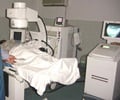LAM-ELISA may not be useful as an independent diagnostic test for pulmonary tuberculosis (TB), a trial has found.
LAM-ELISA may not be useful as an independent diagnostic test for pulmonary tuberculosis (TB), a trial has found.
Detailed in the open access journal BMC Infectious Diseases, the results suggest that it was only capable of identifying 50.7 per cent of TB cases.Klaus Reither led a team of researchers from the Ludwig-Maximilians-University of Munich, Germany, the University College London, UK, and the NIMR-Mbeya Medical Research Programme, Tanzania, who tested LAM-ELISA in 291 Tanzanian patients suspected of having TB.
He said: "Only 35 out of 69 pulmonary TB cases, confirmed by smear microscopy and/or solid culture and/or liquid culture, showed at least one positive LAM-ELISA result. This 50.7 per cent sensitivity of the LAM-ELISA was disappointingly low. The specificity of 87.8 % also fell far short of expectations."
The LAM-ELISA detects lipoarabinomannan (LAM), a mycobacterium-specific lipopolysaccharide component of the bacilli's cell wall.
In active mycobacterial disease, LAM is released into the blood and passes the renal barrier without major changes - suggesting that its detection in urine should be a reliable diagnostic indicator.
Urine can be easily obtained, and its collection is often more culturally accepted than the collection of sputum or blood samples.
Advertisement
"In our opinion, further investigations are needed to elucidate if the LAM-ELISA, in this stage of development, is valuable as a supplemental tool for the diagnosis of HIV-associated TB. This seems particularly important, when taking into consideration that TB is one of the most important opportunistic infections of HIV patients and that the sensitivity of smear microscopy in immunocompromised patients is low," they say.
Advertisement
RAS















